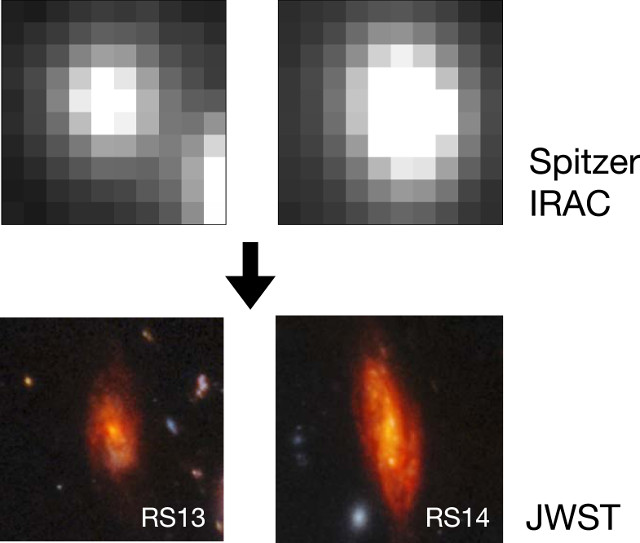
An article published in “The Astrophysical Journal Letters” reports the identification of a population of rare red spiral galaxies in the SMACS J0723.3-7327 galaxy cluster. A team of researchers used observations conducted with the James Webb Space Telescope to find details of these galaxies which are estimated to date back to when the universe was about two to three billion years old.
The unprecedented detail captured by Webb helps to make progress in understanding the processes taking place in galaxies of various ages and understand why some appear red. Finding several very old ones suggests that over 10 billion years ago, red galaxies were more common.
Spiral galaxies are one of the most common types and include the Milky Way. They have a structure that allows them to be active in the formation of new stars, and this gives them a bluish color thanks to their massive young stars. However, there are galaxies whose color tends towards red, a characteristic that can be explained by the very predominant presence of ancient stars or large amounts of dust that alters their color by blocking frequencies around the blue. Understanding which is the case or if there’s a mix of the two possibilities requires that enough details are obtained.
The galaxy cluster SMACS J0723.3-7327 was the subject of the first full-color photo released after the start of the James Webb Space Telescope science mission. There was the desire to show the public what an instrument could do after years of being at the center of controversy due to costs and construction delays, but the astronomical work remains crucial and this also applies to this image.
Yoshinobu Fudamoto, Akio K. Inoue, and Yuma Sugahara of Waseda University, Japan, conducted an analysis of the many galaxies portrayed in the image of the SMACS J0723.3-7327 cluster and discovered several red spiral galaxies. The three researchers focused in particular on the two reddest galaxies, cataloged as RS13 and RS14, with interesting results.
Like many other cosmic objects now studied with the James Webb Space Telescope, the galaxies RS13 and RS14 were already known but other instruments are unable to capture the details of their structures. The image (NASA/STScI) shows these two galaxies as they appeared in images captured by the Spitzer Space Telescope and as they appear in the image captured by Webb. The difference is huge and the data obtained thanks to Webb offers many more possibilities for analysis.
The galaxies RS13 and RS14 belong to what is known in jargon as the cosmic noon, a period between about 8 and 10 billion years ago which followed the so-called cosmic dawn, which was the first phase of life of the universe. Red galaxies are rare, so finding several of them in the cosmic noon suggests that they may have been much more common at the time than they are today.
Examination of the galaxy RS14 indicates that it’s passive, meaning that no new stars are forming within it. The red color is due to the presence of ancient stars only and red dwarfs are the most numerous. That’s a surprising result given that astronomers expect to find young stars in a spiral galaxy, especially in a primordial one that is supposed to still contain a lot of hydrogen.
A hypothesis offered in previous studies on the subject is that red galaxies are in a phase of their evolution in which a new generation of stars is still in the formation phase, therefore we can’t see their light. It’s a topic that may also be of interest to astronomers studying the influence of supermassive black holes on star formation in their host galaxies. The article concerning the galaxies RS13 and RS14 is a pilot study about spiral galaxies in the early universe. That type of study will be developed thanks to new observations conducted with the James Webb Space Telescope.

